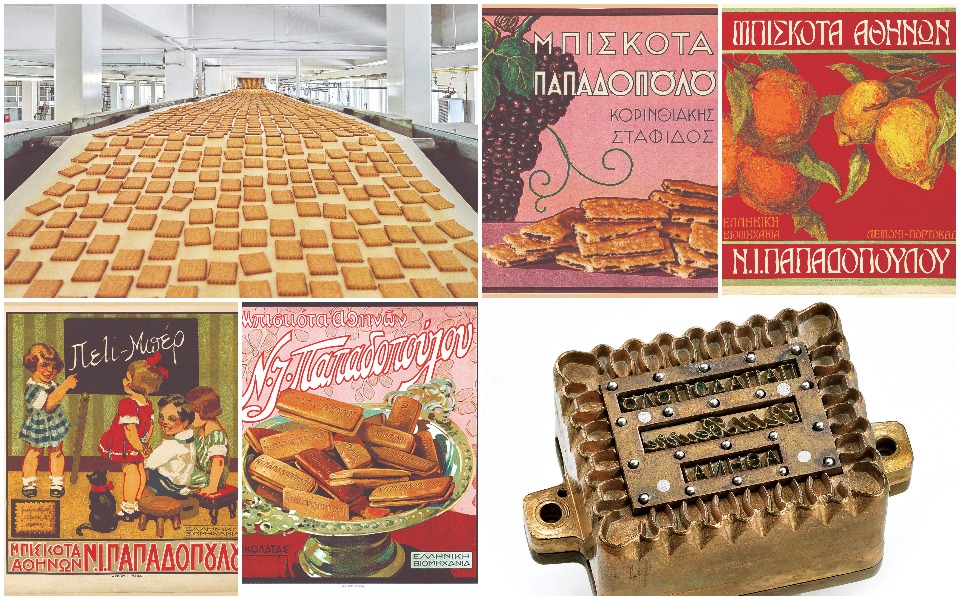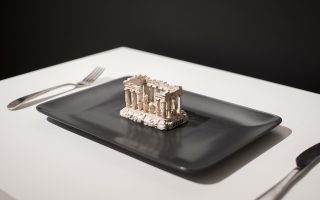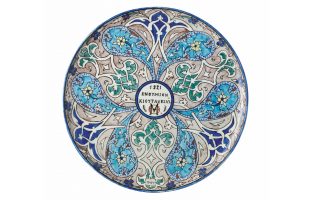Celebrating the centennial of a Greek cookie icon

The letter is dated January 31, 1949, Rome. “Dear Evangelos,” it begins. “I will not be back for a long time. I will continue my journey to other parts of Europe so that I can be fully trained in the techniques of our business, and we can present products that are perfect in every respect once I return to Greece. Kisses, Nikos.”
The dining room table of the Papadopoulos family, laid out for a big Sunday meal, is the centerpiece of the Benaki Museum’s impressive and original new exhibition, “Papadopoulos 100: The Story of the Company 1922-2022.” Arranged around the table in an orderly fashion, the chairs look like they’re waiting for the guests to arrive, pull them out and bring the stage-like setting to life.
Displayed on the ground floor of the museum’s Pireos Street annex, it is a familiar setting that puts the visitor instantly at ease, making you feel like a guest in a private home. And like a close friend, you can also peek through the half-open door into the elegantly lit office of Evangelos I. Papadopoulos, with its heavy wooden furniture and old black typewriter.
Indeed, one of the exhibition’s chief aims is to acquaint the public with the family behind the company. There is a big family tree covering one of the walls and dramatized readings (in Greek) of the private correspondence between brothers Nikos and Evangelos Papadopoulos in the period from 1949 to 1953, featuring actors Konstantinos Markoulakis, who also directed the segment, and Odysseas Papaspiliopoulos, with a soundtrack by Thodoris Economou. From these samples of their correspondence, which is one of the treasures of the Papadopoulos firm’s historic archive, visitors are given insight into the founders’ philosophy and character – and possibly to the company’s success, as their dedication, hard work and attention to quality and detail is more than apparent.
The exhibition is separated into 10 sections covering every important phase in the history of one of the biggest names in the Greek food industry. It is also a beautifully curated show that adds richness and texture to what is already a fascinating narrative, with each section arranged in a thematically relevant setting.
The first section deals with the brand and the way in which it became a household name thanks to its successful packaging and advertising, with exhibits including old labels and print and television ads. Its products and their production are the focus of the next few sections, followed by a brief history of the firm and then a small section dedicated to stories that have drawn inspiration from the themes of cookies, bread, dough etc. The people behind the company – from the workers on the production lines to the executives in the offices – are also honored before we get to the main part of the show, which is about the food itself and the ingredients that go into them.
A journey that involves all the senses and is interesting for youngsters and adults alike, the Benaki show comprises more than 300 exhibits, a wealth of audiovisual material and several interactive stations, such as a game inspired by the firm’s employees or a series of small drawers containing surprise exhibits. This modern and engaging layout was designed and supervised by the architecture and design firm Kizi Studio, while the show is curated by Erato Koutsoudaki.
With exquisite attention to detail, the exhibition is a marvelous showcase of the Papadopoulos company’s historical archive, which is regarded as one of the most comprehensive and well-organized of its kind in Greece. This is also the first time that its treasures are being shown to the public, something that was to a great degree possible thanks to the work of archive supervisor Stefanos Vameiadakis, who in 2014 started locating and documenting every scrap of material related to the company’s history that he could find. This collection now ranges from documents and accounting books, to photographs, packaging and posters, display boards, ads, decorative objects, souvenirs and a plethora of other items.
The archive combined with the company’s financial records also represents the key sources of a study on the company by historian and writer Kostas Kostis and economist Kostas Stratis. Framed in the context of Greece’s broader social and economic evolution from 1922 to the present, their study has been published as part of the anniversary exhibition in a beautifully designed tome with a wealth of photographs.
It picks up the story of the Papadopoulos family at the start of the 20th century, when they were among the well-established Greeks of Constantinople. Like so many others, they came to Greece during the Asia Minor Catastrophe, though there are few details of their lives until then apart from the knowledge that the family had some previous experience in baking biscuits.
According to the authors of the study, letterheaded stationery from the company in the 1920s puts the year of its foundation as 1916 and its provenance as Constantinople. How they became biscuit bakers is unknown, but what we do know is that the first cookie made by Papadopoulos in Greece was its iconic Petit-Beurre, a dry, square biscuit with toothed edges – as per its international equivalent.
According to the private family history, these biscuits were originally made by the family matriarch at home and then sold by the sons who went around Constantinople with big trays of their wares. They are rumored to have rivaled even the best English biscuits sold at the time, and were stamped with the logo “Papadopoulos Brothers, Constantinople,” to distinguish them from the competition.
When the expulsion of the Greeks from Asia Minor began, the family had initially aimed to flee to Western Europe, according to Kostis and Stratis. They were en route to Marseilles when their ship stopped at Piraeus and they disembarked to stretch their legs and have a snack at a cafe, where they ordered coffee and biscuits. According to the study, their water admitted that he had never heard of biscuits and could only bring them coffee. Indeed, a registry of businesses from 1920 shows only one biscuit manufacturer in Greece, at 57 Panepistimiou Street and owned by K. Tsitas.
Evangelos Papadopoulos had also noted the problem in one of his letters to his brother, saying that with the exception of a few English biscuits imported to Corfu and a handful of shops in Athens, biscuits were basically unknown in Greece.
This changed with the arrival of the Papadopoulos family, which ushered in the age of the biscuit in Greece in the interwar years. In a country where most families struggled to make ends meet, it transformed a luxury item into one that was affordable – and very, very popular.
“Papadopoulos 100: The Story of the Company 1922-2022,” runs through February 27 at the Benaki Museum annex at 138 Pireos Street. Opening hours are Thursdays and Sundays from 10 a.m. to 6 p.m. and Fridays and Saturdays from 10 a.m. to 10 p.m. For more details, visit benaki.org.





